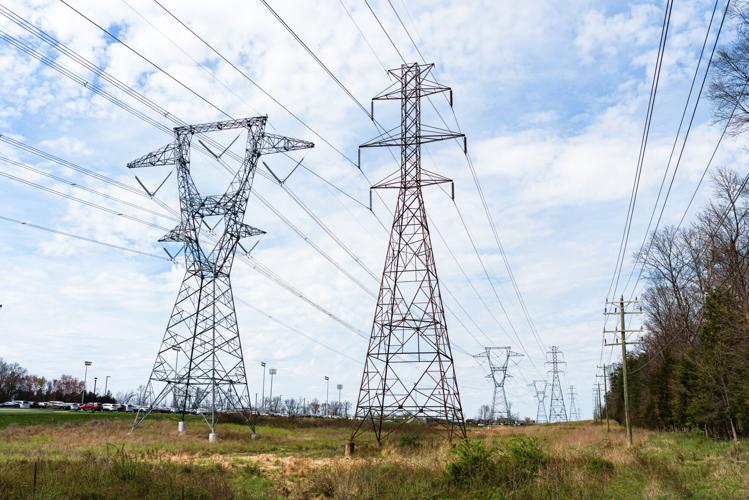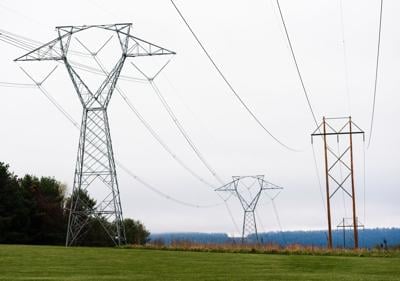Echoing concerns from county residents and activist groups, county supervisors unanimously passed a resolution April 16 calling for NextEra Energy’s proposed transmission lines to be routed on existing transmission corridors rather than building a new path through western Loudoun.
NextEra is proposing to build 500-kilovolt transmission lines from the proposed Woodside substation outside Winchester near the West Virginia border, through western Loudoun, and to the proposed Aspen substation outside Leesburg near Cochran Mill Road. The lines are part of NextEra’s proposed MidAtlantic Resiliency Link project that would span 130 miles across Virginia, West Virginia, Pennsylvania and Maryland.
The resolution “encourages NextEra Energy to work with the electric utility providers in Virginia, West Virginia, and Maryland to collocate the new transmission lines in exiting electrical transmission corridors.”
Instead of using the Woodside to Aspen route, a county staff report suggests, NextEra could “redirect the route from the Woodside substation to the Doubs substation” in Frederick County, Maryland, then cross the Potomac River going south to the Aspen substation. This would use existing Pepco and Dominion Energy corridors.
“There are 230 and 500 kV lines that are running in that route, and maximization of those towers could account for the power that NextEra wants to bring to Loudoun County,” County Attorney Leo Rogers said. “... They may need new towers, as some of the towers would have to have double circuits on them, and that’s probably the solution.”
The county has no formal jurisdiction over transmission line routing.
Another existing 500-kilovolt transmission line crosses western Loudoun in the Lovettsville area and a 230 kV line along Route 7 terminates at a substation outside Purcellville.

Hundreds of miles of electric transmission lines (in red) crisscross the Northern Virginia area. The high-voltage lines connect power plants — like the Potomac Energy Center, a natural-gas plant south of Leesburg — to substations, from which electricity is distributed either to end users or to other substations. (Transmission line map files via the U.S. Department of Homeland Security’s Homeland Infrastructure Foundation-Level Data)
“This resolution sends a very important message to NextEra,” said Supervisor Caleb Kershner (R-Catoctin), who represents most of rural western Loudoun. “... I think it’s largely unanimous throughout the community that we find the correct route, which we believe in this resolution is the existing right-of-way.”
“There’s just too much at stake,” he said, adding that supervisors should “do everything we can as a board to protect” the county’s historical and agricultural resources.
Supervisor Kristen Umstattd (D-Leesburg), who represents the area where the Aspen substation is proposed, said she was happy to support the resolution but “pessimistic that this is going to result in what we hope it will result in.”
“One of the conversations that I’ve had with the NextEra folks indicates that, from their perspective, some of the existing transmission corridors do not have adequate room to run additional lines because of how close they already are to existing residential communities,” she said. “So I think this is a worthy effort. Whether we will succeed I think is a whole other question.”
Rogers said the NextEra proposal was “preliminarily approved” by PJM Interconnection, a regional transmission organization that plans for future energy needs and coordinates electricity projects throughout 13 states and Washington, D.C.
PJM advanced the proposal and several others in December to address “increased electricity demand, combined with the retirement of fossil-fuel generators” in the region, according to a PJM frequently asked questions sheet. NextEra will still need approval from the State Corporation Commission, which has sole jurisdiction over the final route.
NextEra has not released specifics about the proposed route and has not yet filed an application with the SCC.
“We are early in the process, and no final route has been selected,” NextEra said through a spokesperson on April 17. “We continue to evaluate a number of options and to engage with local communities and stakeholders.”
NextEra has, however, applied for a “national interest electric transmission corridor” designation with the U.S. Department of Energy.
“As part of our commitment, we filed for a NIETC designation, a process where the U.S. Department of Energy recognizes an area as requiring additional transmission infrastructure to provide customers with reliable and affordable electricity, which would align with PJM’s determination of the urgent need in the region,” a NextEra spokesperson said April 4.

Electric transmission and distribution lines cross Hal and Berni Hanson Regional Park between Brambleton and Willowsford.
NextEra declined to say which area the NIETC application is for, and the U.S. Department of Energy has not yet released the list of possible corridors.
NIETC corridors are considered “priority” areas for new transmission infrastructure that would have access to “key federal financing and permitting tools to spur construction of urgently needed transmission infrastructure,” according to the Department of Energy. The financing and permitting tools include direct loans, public-private partnerships and federal construction permits through the Federal Energy Regulatory Commission.
Notably, the Federal Energy Regulatory Commission would be allowed to overrule state authorities in some cases, “such as when states lack the authority to site the project, have not acted on an application after more than one year, or have denied an application,” according to the department.
In those cases, the FERC could potentially overrule Virginia’s State Corporation Commission on transmission line proposals like NextEra’s.
Residents and activists across the county have mobilized against NextEra’s proposal, calling it a threat to the rural economy and to western Loudoun’s natural and historic resources. Several spoke during public comments that night supporting the resolution.
Jim Hanna, of the Loudoun Transmission Line Alliance, called the NextEra proposal a “serious threat.”
“The alliance does not oppose, but indeed supports, the overall PJM regional transmission expansion plan aimed in particular to meet the rising power needs of the region’s data center industry,” he said. “The alliance does firmly oppose NextEra’s proposal for a new transmission path anywhere in western Loudoun and requests NextEra to withdraw this proposal” and “select an existing right-of-way” for it.
“For NextEra, this is a commercial decision,” he said. “But for Loudoun, it is existential.”
Bryan Turner, the attorney representing the Lansdowne Conservancy to oppose Dominion Energy’s Aspen to Golden transmission line proposal along Route 7, spoke for the resolution in solidarity with those opposing the NextEra lines.
“Western and eastern Loudoun are aligned in this message: Dominion must bury 500 kV lines where it’s feasible to do so. And NextEra must build in locations where power lines already exist,” he said.
Supervisors recently voted to issue a “notice of participation” in Dominion’s SCC application for the Aspen to Golden project, which seeks to build 9.4-mile overhead transmission lines on the south side of Route 7. The project would use both 500- and 230-kilovolt lines to connect the Aspen substation to the proposed Golden substation in Ashburn near where the Washington and Old Dominion Trail intersects with Route 28.
“As you’ve heard from several of the speakers tonight, there’s tremendous impacts to the county on its rural economic development, agriculture, history, the equine industry, tourism, historic structures, landmarks,” Rogers, the county attorney, said of the NextEra Proposal.
Earlier that evening, before the vote on the resolution, Supervisor Matt Letourneau (R-Dulles) pointed out that there are transmission lines across the county, including “some in the Dulles District that came in a number of years ago that I was not particularly pleased with either. We were able to move those a little bit.”
“I really can’t emphasize enough the need to marry local land use with planning utility commitments and requirements, and the regional picture,” he said. “And the biggest problem is, those pieces are all floating independently and they’re not together — they’re not working together.”
“I actually think the industry — particularly the data center industry itself — needs to help us with that because it’s in everybody’s interest,” he added.















(0) comments
Welcome to the discussion.
Log In
Keep it Clean. Please avoid obscene, vulgar, lewd, racist or sexually-oriented language.
PLEASE TURN OFF YOUR CAPS LOCK.
Don't Threaten. Threats of harming another person will not be tolerated.
Be Truthful. Don't knowingly lie about anyone or anything.
Be Nice. No racism, sexism or any sort of -ism that is degrading to another person.
Be Proactive. Use the 'Report' link on each comment to let us know of abusive posts.
Share with Us. We'd love to hear eyewitness accounts, the history behind an article.